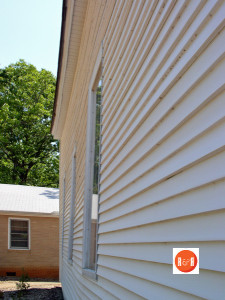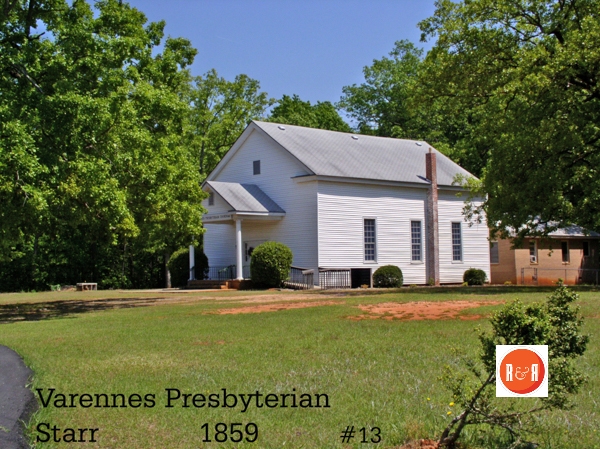City Directories and History: This church was constructed in 1859 in the traditional meeting house style of architecture. The congregation had been established in 1813.
Varennes Township took its name from old Varennes Church. It had been a social center for many years, having been one of the earliest churches in the section. The word Varennes is French and means waste land. A school here was even older than the church. The tornado of February 16, 1903, is reported to have lifted the Varennes Township School from its foundation, causing it to skid along on the ground and lodge against some oak trees. All children in the building escaped injury, although every pane of glass in the building was shattered. Tradition has it that a Frenchman owned a store at the cross roads where Varennes was first organized, and that the name was adopted at his request as a memorial to the memory of his sweetheart left behind in the hills of France.
The tornado of February 16, 1903, is reported to have lifted the Varennes Township School from its foundation, causing it to skid along on the ground and lodge against some oak trees. All children in the building escaped injury, although every pane of glass in the building was shattered. Tradition has it that a Frenchman owned a store at the cross roads where Varennes was first organized, and that the name was adopted at his request as a memorial to the memory of his sweetheart left behind in the hills of France. There is a book of sessional records beginning in 1860, from which is noted that the Rev. Thomas D. Baird established an Academy upon the Colonel Jesse Norris place where now stands the home of the late Mr. Julius Anderson. This log building then had log seats and an improvised stage; the Rev. Richard B. Cater organized Varennes church in the year 1813 or 1814. In 1837, the church was moved three miles south to land given by James Thompson; then in 1856 or 1857 it became necessary to select a new location near Storeville.
The Yorkville Enquirer reported on Aug. 18, 1886 – “Last Thursday, Anderson celebrated the completion of the Savanna Valley Railroad placing that city in direct communication with Augusta, Georgia.”
Also: Starr was formerly known as Cross Roads and Twiggs; it is located on the C & WC Railroad and was named for an official of the railroad a Mr. Starr, who helped locate the railroad through the village. were one with those of the north does not seem tenable. Starr was centered in the middle of a triangle, a triangle formed by the intersection of six roads at the points of the triangle. This was why the early settlers named the place Cross Roads. Today, the old triangle of roads which are over a hundred years old, are not known to many. The modem highways still follow the old road beds. These roads now are the intersection of State Highways 412 and 181, the intersection of the railroad tracks and the old Abbeville Highway, and the intersections of the Tucker Mill Road and Lowndesville Highway. The rural community of Cross Roads later took on the name of Twiggs, named for a prominent merchant and businessman of that day. Mail postmarked 1892, bore the name of Starr. Among the landmarks soon to be razed at Starr is the old Savannah Valley Railroad (C & WC) station, erected about 1888, when the road was completed. The station was discontinued years ago and recently purchased by John R. Mouchet. The station, bearing the name Starr, will probably be preserved as a museum piece. Another Starr landmark to be wrecked is the big building which once housed the old general store of the Pruitt brothers. The original part of the store was erected in the 1890 s. The store was later enlarged by construction of a wing, becoming one of the largest general stores in Anderson County. The store was closed many years ago, a victim of paved roads. XI: 62 The Starr Baptist Church, called Cross Roads Baptist Church until 1935, dates back to 1825. The brick sanctuary was erected in 1858 and was the first brick Baptist church in Anderson County. Three of the original bricks bearing the masons’ names are still embedded over the door of the church. The initials are MD (Made Dean); PAM (Pressley Masters); JB (Joe Byrum). The date 1858 is also imbedded in one brick.
The Starr Methodist Church was once located several miles from Starr and known as Bethesda Methodist Church. When Starr started growing the church moved into town leaving behind the early cemetery of the church which marks its site. Starr schools have grown from a one-room and one- teacher school to an eleven-teacher elementary school and the high school consolidated with the Iva school into Crescent High in the Good Hope community.
(Information from: Names in South Carolina by C.H. Neuffer, Published by the S.C. Dept. of English, USC)

Construction details courtesy of photographer Bill Segars.

Stay Connected
Explore history, houses, and stories across S.C. Your membership provides you with updates on regional topics, information on historic research, preservation, and monthly feature articles. But remember R&R wants to hear from you and assist in preserving your own family genealogy and memorabilia.
Visit the Southern Queries – Forum to receive assistance in answering questions, discuss genealogy, and enjoy exploring preservation topics with other members. Also listed are several history and genealogical researchers for hire.
User comments welcome — post at the bottom of this page.
Please enjoy this structure and all those listed in Roots and Recall. But remember each is private property. So view them from a distance or from a public area such as the sidewalk or public road.
Do you have information to share and preserve? Family, school, church, or other older photos and stories are welcome. Send them digitally through the “Share Your Story” link, so they too might be posted on Roots and Recall.
Thanks!
User comments always welcome - please post at the bottom of this page.





Share Your Comments & Feedback: